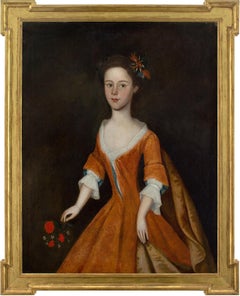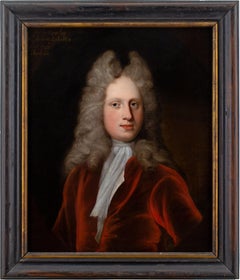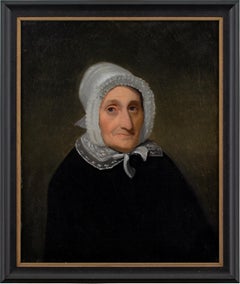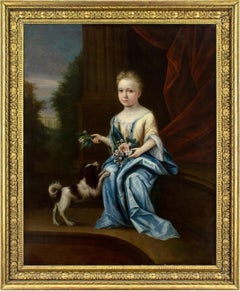Want more images or videos?
Request additional images or videos from the seller
1 of 13
UnknownEarly 19th-Century British School, Portrait Of A Regency Gentlemanc. 1815
c. 1815
$1,205.28List Price
About the Item
- Creation Year:c. 1815
- Dimensions:Height: 26.5 in (67.31 cm)Width: 23 in (58.42 cm)
- Medium:
- Movement & Style:
- Period:
- Condition:Assessed and left predominantly as found for aesthetic effect. Cleaned. Canvas relined. Fine and settled craquelure, as you would expect. The paint layer is stable. Minor scuffs. Discoloured varnish.
- Gallery Location:Cheltenham, GB
- Reference Number:1stDibs: LU2328214428562
About the Seller
5.0
Platinum Seller
Premium sellers with a 4.7+ rating and 24-hour response times
Established in 2017
1stDibs seller since 2023
248 sales on 1stDibs
Typical response time: 3 hours
Authenticity Guarantee
In the unlikely event there’s an issue with an item’s authenticity, contact us within 1 year for a full refund. DetailsMoney-Back Guarantee
If your item is not as described, is damaged in transit, or does not arrive, contact us within 7 days for a full refund. Details24-Hour Cancellation
You have a 24-hour grace period in which to reconsider your purchase, with no questions asked.Vetted Professional Sellers
Our world-class sellers must adhere to strict standards for service and quality, maintaining the integrity of our listings.Price-Match Guarantee
If you find that a seller listed the same item for a lower price elsewhere, we’ll match it.Trusted Global Delivery
Our best-in-class carrier network provides specialized shipping options worldwide, including custom delivery.You May Also Like
Portrait of Lady Mansfield of Ringwood
By Thomas Hudson
Located in London, GB
Portrait of Lady Mansfield of Ringwood
Oil on Canvas, unsigned
Image size: 25 x 30 inches (63 x 76 cm)
Original carved & gilded frame
Provenance
Descended through the Family Estate
Born in Poland in 1760 to the 2nd Earl of Mansfield and his wife, Elizabeth Mary Murray would later come under the care of her uncle, William Murray (1st Earl of Mansfield) at Kenwood House in Hampstead. David Murray (2nd Earl of Mansfield) was set to inherit the title and full wealth of his uncle, including Kenwood House. Lady Mansfield’s second cousin would soon join her at Kenwood, where they would be raised together and featured in multiple portraits of the time. Her younger sister, Henrietta, is seen in a separate portrait done by Thomas Hudson as well. At the age of 25 she married George Finch-Hatton, an English aristocrat and politician who sat in the House of Commons from 1772-1784.
Gazing out at the viewer, Lady Mansfield wears a decorated dress, with an abundance of pearls and lace, and a transparent gold lined veil surrounding her right shoulder. The excess of luxurious fabric matches another Hudson portrait of another Lady Mansfield, with the lace detailing and complementary bodice. The depiction of this Lady Mansfield epitomizes the style of portraiture in the 18th century, such as the styles Hudson’s pupils Joshua Reynolds, Joseph Wright, and Peter Toms. From Hudson’s travels to the Low Countries and Italy, he no doubt brought back artistic inspiration from the international pieces he encountered.
Thomas Hudson
Hudson was a celebrated 18th century portrait painter. Born in Devon in 1701 he studied under the artist Jonathan Richardson and married his daughter, against Richardson’s wishes.
He had many artistic friends including William Hogarth and Francis Hayman and travelled with them in Europe in 1748. He also visited Italy with the sculptor Louis-François Roubiliac in 1752. Hudson’s style of portraiture proved so successful that for a decade from 1745 to 1755 he was London’s most popular portrait painter and made a fortune painting the cream of London society and members of the Royal Family.
He was also a talented teacher, perhaps too good, as subsequently a number of his former assistants overtook him in popularity including the artist Joshua Reynolds.
Hudson retired in the late 1750’s and died in Twickenham in 1779. His most notable works include portraits of King George II and George Friedrich Handel and his “Portrait of a Nobleman in Van Dyck dress.” Many of Hudson’s works may be seen in art galleries. These include the National Portrait Gallery, the National Maritime Museum, the Tate Gallery, the Foundling Museum and the Bristol City Museum and Art Gallery. His works are also in Museums across the world...
Category
18th Century English School Paintings
Materials
Canvas, Oil
Portrait of Lady Mansfield of Ringwood
By Thomas Hudson
Located in London, GB
Portrait of Lady Mansfield of Ringwood
Oil on Canvas, unsigned
Image size: 25 x 30 inches (63 x 76 cm)
Original carved & gilded frame
Provenance
Descended through the Family Estate
...
Category
18th Century English School Paintings
Materials
Canvas, Oil
NEOCLASSICAL FIGURE -In theManner of J. W. Godward Italy Oil on canvas painting
By Eugenio De Blasi
Located in Napoli, IT
Sweet Dreams - Oil on canvas painting, Eugenio De Blasi, Italy, 2011
Gold leaf gilded wooden frame cm. 134x94
The painting by Eugenio De Blasi is inspired by the painting "Sweet Dreams" by John William Godward, a neoclassical Victorian painter...
Category
2010s English School Figurative Paintings
Materials
Canvas, Oil
$5,805
H 43.31 in W 27.56 in
Men portrait with a hat
Located in BELEYMAS, FR
Henry William Pickersgill, attributed to
(London 1782 – London 1875)
Portrait of Captain Samuel Wright
Oil on canvas
H. 92 cm; L. 73 cm
Circa 1810/1815
Provenance:
– Brother of the ...
Category
1810s English School Portrait Paintings
Materials
Oil, Canvas
Antique Late 19th Century English Oil on Canvas Painting Female Portrait 1900
Located in Portland, OR
Antique English oil on canvas portrait painting, circa 1900. A very handsome Impressionist portrait of a youthful lady in Edwardian dress. Oil on canvas, signed to the upper left "F ...
Category
Early 1900s English School Portrait Paintings
Materials
Canvas, Oil
$1,900
H 33.25 in W 29.5 in D 2 in
A Portrait of a Lady
Located in San Francisco, CA
Viewing the delicacy and grace of this portrait, one can appreciate that British artist Rosa Koberwein (1876–1903) was well recognized during her career for producing excellent portr...
Category
Late 19th Century English School Portrait Paintings
Materials
Canvas, Oil
Portrait After John Constable, Sotheby's Provenance
By John Constable
Located in New York, NY
After John Constable (British, 1776-1837)
Portrait of A Man, c. 1800
Oil on canvas
23 3/4 x 19 3/4 in.
Framed: 34 x 29 3/4 x 2 3/4 in.
Sotheby'...
Category
19th Century English School Portrait Paintings
Materials
Canvas, Oil
Sailor Smoking a Pipe
By Arthur David McCormick
Located in London, GB
Sailor Smoking a Pipe
Arthur David McCormick
Oil on canvas
Image size: 19 x 25 1/2 inches (48 x 65 cm)
Contemporary frame
Arthur David McCormick (1860–1943) was a notable British illustrator and painter, renowned for his landscapes, historical scenes, naval subjects, and genre scenes. Born in Coleraine, County Londonderry, he pursued his education at the Royal College of Art in London from 1883 to 1886.
McCormick’s career was marked by his contributions to various illustrated magazines, including the English Illustrated Magazine and the Illustrated London News. He participated in significant expeditions, such as Sir Martin Conway’s journey to the Karakoram Himalayas in 1892 and Clinton T. Dent’s expedition to the Caucasus Mountains in 1895. His illustrations from these travels were featured in Conway’s book “Climbing and Exploration in the Karakoram-Himalayas” (1894) and his own publication “An Artist in the Himalayas” (1895).
Throughout his career, McCormick illustrated nearly thirty books, focusing on travel and adventure themes. Some of his notable works include illustrations for Edgar Allan Poe’s “Tales of Mystery and Imagination” (1905) and Henry Newbolt’s “Drake’s Drum and Other Songs of the Sea” (1914). He was also a regular exhibitor at the Royal Academy from 1889 to 1938.
Navy Cut Sailor Work...
Category
20th Century English School Portrait Paintings
Materials
Canvas, Oil
Portrait of Thomas Cooper Gotch, 19th Century Oil Painting
Located in London, GB
Oil on canvas on board
Image size: 7 x 5¼ inches (18 x 13.5 cm)
Framed
This portrait of Thomas Gotch is by his lifelong friend and confidante, Jane Ross, whom he met at Heatherley’s...
Category
1880s English School Portrait Paintings
Materials
Canvas, Oil
Portrait of a Gentleman Commoner at Oxford, 18th Century Oil on Canvas
By James Northcote b.1746
Located in London, GB
James Northcote
Portrait of a Gentleman Commoner at Oxford
Oil on canvas
Image size: 30 x 25 inches (76 x 63.5 cm)
Original gilt frame
This painting is a comparatively rare example ...
Category
18th Century English School Portrait Paintings
Materials
Canvas, Oil
More From This Seller
View AllMid-18th-Century English School, Portrait Of A Girl With A Posy
Located in Cheltenham, GB
This exceedingly charming mid-18th-century English oil painting depicts a girl wearing a red gown with a train over a white petticoat. She’s holding a posy or nosegay.
Evidently once commissioned for an English country house, the identity of this young lady remains a mystery. Her gown appears to be inspired by the popular ‘robe à la française...
Category
1740s English School Portrait Paintings
Materials
Canvas, Oil
Michael Dahl (Circle), Portrait Of Thomas Stanley
Located in Cheltenham, GB
This early 18th-century English School portrait depicts Thomas Stanley wearing a striking red velvet suit, white cravat and powdered periwig. Fashionable, yet elegantly refined. On t...
Category
Early 18th Century English School Portrait Paintings
Materials
Canvas, Oil
Mid-19th-Century French School, A Pair Of Nanas, 2 x Oil Paintings
Located in Cheltenham, GB
This charming pair of mid-19th-century French School portraits depicts two grandmothers, both presumably widows, wearing black gowns and white bonnets.
Alas, the identity of these r...
Category
Mid-19th Century Portrait Paintings
Materials
Oil, Canvas
John Verelst (Circle), Portrait Of A Young Lady With A Spaniel
By John Verelst
Located in Cheltenham, GB
This large early 18th-century full-length portrait depicts a seated young lady before a classical column and distant country house. It was formerly in the collection of Dalham Hall i...
Category
Early 18th Century Rococo Portrait Paintings
Materials
Canvas, Oil
Rowland Holyoake, Portrait Of A Girl With Wildflowers
Located in Cheltenham, GB
This charming late 19th-century oil painting by British artist Rowland Holyoake (1861-1928) depicts a girl carrying wildflowers while wearing a straw hat decorated with the same. It ...
Category
1880s Pre-Raphaelite Portrait Paintings
Materials
Canvas, Oil
Early-18th Century French School, Ex-Voto Portrait With Emilian Jacobin
Located in Cheltenham, GB
This splendid early 18th-century French oil painting represents an ‘ex-voto’ with Emilian Jacobin and a depiction of the Virgin Mary with Christ and angels.
Ex votos are votive offe...
Category
1710s French School Portrait Paintings
Materials
Oil, Canvas
Recently Viewed
View AllMore Ways To Browse
Regency Oil Painting
Antique Shirt Collars
Regency Portrait Of
Regency Oil Portrait
Sir William Beechey
English Regency Portrait
Duchess Of Marlborough
English Civil War
Lady Jane
Lady With A Fan
Native American Indian Paintings
Oil Portrait Officer
Oil Portraits Of Handsome Young Man
Painting Of A Salon
Portrait Of Maurice
Rembrandt Oil Painting
Antique Baby Portrait
Charlize Theron



